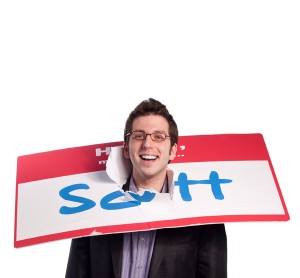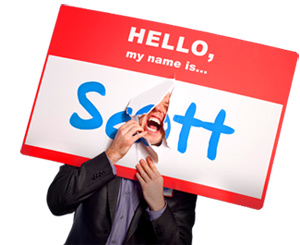You’ve chosen an uncertain path.
You’ve adopted an inconvenient lifestyle.
You’ve embarked upon an unconventional journey.
You’ve felt the voice inside you growing more urgent.
You’ve committed yourself enough so you can’t turn back.
IN SHORT: You’ve decided to play for keeps.
This is the critical crossroads – the emotional turning point – in the life of every young artist.
I’ve been there myself, and here’s a list of suggestions to help you along the way: (Read part one here, part two here, part three here, part four here, part five here, part six here,
part seven and part eight.
1. Take something familiar and play off it. Famed graphic designer and illustrator Alan Fetcher once said, “Stroke cliché until it purrs like a metaphor.” If you want to put that advice into play, you have to go back to official definition of the word cliché – a bankrupt idea.
That’s all it is. Which means the idea still has potential, but only if you use it wisely. The secret is to reinvest in the cliché. To put some cash back into its account and leverage it in a way that is unexpected.
As a writer, I conduct this transaction daily. I find something I can play against – then violate the expectation to prove my point. For example:
*If you don’t know where you’re going, nobody can stop you.
*Curiosity killed the cat, but it also made me a lot of money.
*The best way to bring home the bacon is to raise your own pigs.
*It’s not who you know, it’s whose life is better because they know you.
See the trend? I wonder what would happen if you were unafraid to revisit old ideas. I wonder how customers would react if you stood ideas on their head.
Remember: When you give an old idea a new twist, you deepen its meaning and extend its potential. Be confident enough to borrow from the past, but be smart enough to build into the present. Are you too cool for cliché?
2. Creativity is forever. Maya Angelou once said, “The more creativity you use, the more you have.” Here’s a rapid-fire list of strategies to make sure you never run out: First, go to the edge of your field of vision. Transcend the conventional boundaries of your craft. Like the writer who takes a painting class.
Second, keep your complex engine of experience well oiled and fully serviced. Make an investment in your future interestingness by saying yes to every new experience. And vigorously pursue avenues that enhance your sensibility and enliven your spirit.
Third, never deplete your reservoir of curiosity, your databank of possibility and your arsenal of ingredients. Restock them by finding value in the discarded. By seeking out the inherent novelty in everything you encounter.
Fourth, practice seeing the potential in the ordinary. The memorable in the mundane. Attend to every idea you discover with deep democracy. And believe there is no such thing as a bad idea.
Fifth, put your mind in a state where it is willing to accept. Surrender control of the creative process. And remember that your art comes through you, not from you.
Last, turn off your conscious mind. Go perpendicular to the task at hand. Rely on your brain to do the work for you while you’re engaged in something else. How will you enable the art that matters to bubble to the surface?
3. Let yourself get lost. Serendipity is the breeding ground for novelty. Unfortunately, technology is like a digital bulldozer. Here’s why: Because we’ve become accustomed to instant informational gratification, it’s getting harder and harder to joyfully let your curious mind go wherever it needs to go.
Nothing against search engines, but finding exactly what you were looking for – the instant you start looking for it – eliminates many of the wonderful accidents that could have sent your brain into unexpected territory. And you focus on trying to undo your mistake instead of developing it into something great. Yikes.
That’s why it’s helpful to go analog for some portion of your creative process. Even if you would rather stab yourself with the pen than actually write with it, you can’t beat ink.
Personally, I still keep handwritten journals. And I write in them every day. What’s more, I still read books made out of paper. I dig they way they feel, love the way they smell and enjoy stumbling into verbal accidents while flipping through the pages.
The point is: The slip of the pen is the spark of the mind. And sometimes we have to lose our direction to find our way. Are you listening to your unintentional music?
4. Prolong the encounter. The best part about making art is, people don’t have to get your work right away. In fact, a delayed response is better than an immediate reaction. Think about it: Wouldn’t you rather have someone pouring over your work for ten minutes than glancing at it for ten seconds? I know I would.
In fact, that was the motivation behind my latest project, Brandtag Identity Collages. My goal was to mash together design, marketing, writing and leadership into a public piece that made people blink — then think. A work of art so striking that it forced people to stop, squint, cross their arms, start pondering, and invite their friends to join in the fun.
As I learned from Hugh McLeod, “It’s not just a work of art, it’s a social object.”
That’s how you burn the moment into people’s brains: By delivering art that’s familiar enough to be understood, but unusual enough to be engaging. Focus on that, and your work will go beyond surface value. It will reward people from any angle.
And the more they look at it, the more it will repay them. When people pay attention to you, are you keeping the change?
5. Feel the need for slow. When Jimmy Wales created Wikipedia, his vision was simple: Instant, free access to the sum of all human knowledge. Which sounds pretty cool for marketing purposes.
Unfortunately, human beings are not constructed to acquire information as fast as they can get it. That’s the problem with constant connectivity: People have bought into the lie that every minor incident is a supertragedy. That every piece of information is a crisis.
But it’s not – it all just noise. And the moment you allow life to come crashing in at a speed your constitution can’t handle, your art will be the first thing to suffer.
My suggestion: Slow down. Press the off button. And delete whatever distractions and obligations are clogging up your intuition and chipping away at your capacity for concentration. Otherwise you’ll be spend all your time checking your email in traffic when you should be ship the art you were born to create.
Remember: Success is a process of elimination. Take up your chisel and start chipping away what doesn’t matter. Unencumbered by life’s accumulations, you’ll create something that does. Do you have an office or a distraction factory?
6. Stick yourself out there. Alan Fletcher also said, “I don’t know where I’m going, but I’m on my way.” That’s the attitude every young artist needs to embrace, he says. The courage to close your eyes and jump into the dark, aware that you may land on your face and have to get up smiling.
Look: You can only hide your identity behind a mantle of anonymity for so long. Eventually, you have to bare it. You have to subject yourself to the scrutiny of the cold light of day. Even if people call you names that would make your mother cry.
I understand that your art is an expression of the person you are. And it causes existential pain to have your work kicked to the curb. But in the midst of all the surrounding heartache, you can’t ever lose sight of your own artistic responsibility: To stay loyal to the highest version of yourself.
The cool part is, the more you share, the more they care. The more they care, they more they buy. And as long as you keep your heart open, love will always find its way in. When you stand on the edge of the abyss and realize you can fly, will you jump?
REMEMBER: When you’re ready to play for keeps, your work will never be the same.
Make the decision today.
Show the world that your art isn’t just another expensive hobby.
LET ME ASK YA THIS…
Have you committed with both feet yet?
LET ME SUGGEST THIS…
For the list called, “52 Random Insights to Grow Your Business,” send an email to me, and you win the list for free!
* * * *
Scott Ginsberg
That Guy with the Nametag
Author, Speaker, Publisher, Artist, Mentor
[email protected]
Now booking for 2011-2012!
Watch The Nametag Guy in action here!

